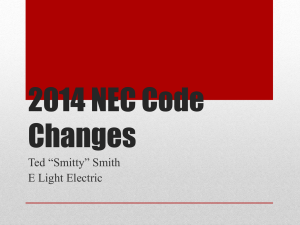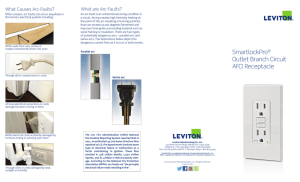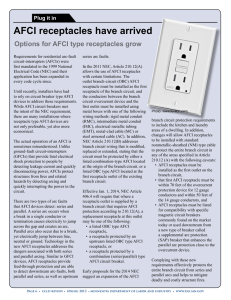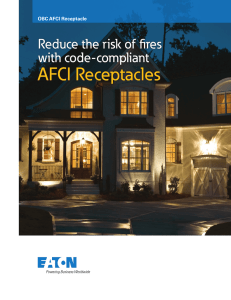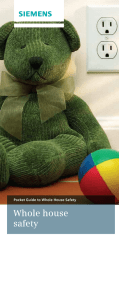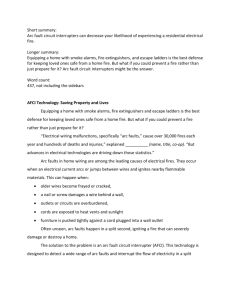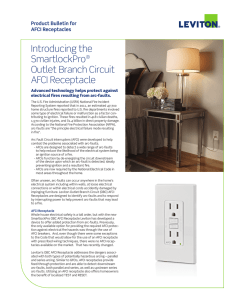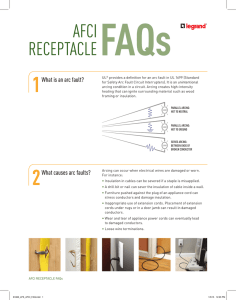Arc Fault Current Interrupter - Hubbell Wiring Device
advertisement
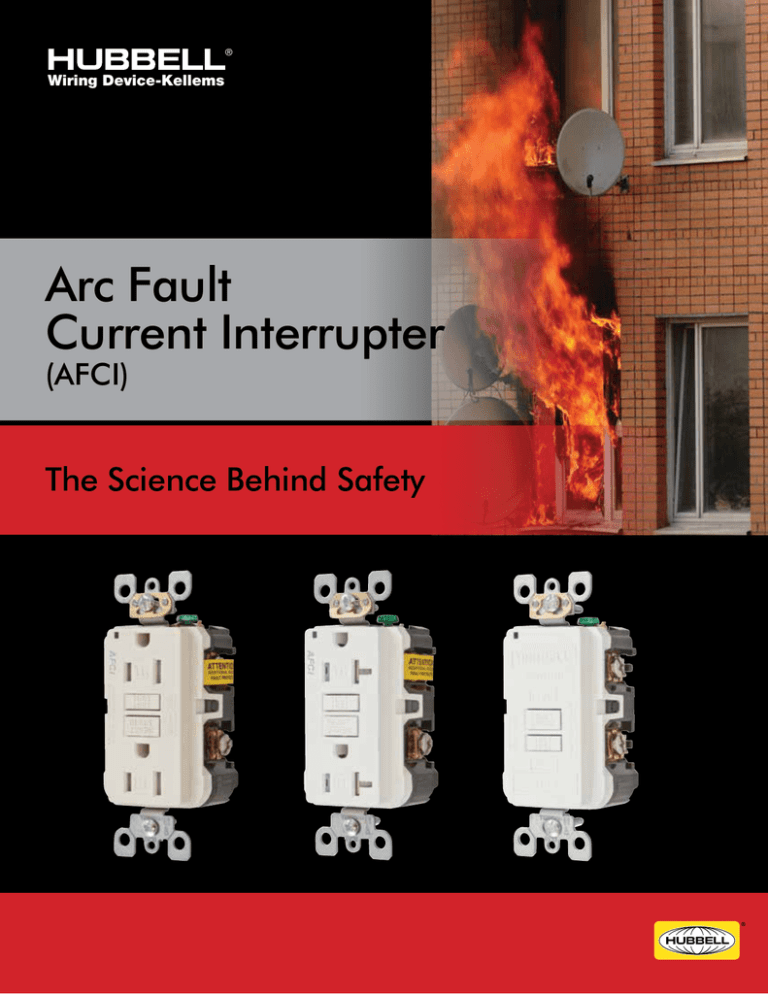
® Wiring Device-Kellems Arc Fault Current Interrupter (AFCI) The Science Behind Safety ® Wiring Device-Kellems Arc Fault Current Interrupter AFCI 101 What is an Arc Fault? An arc fault is the electrical discharge that occurs when electricity “arcs” or unintentionally travels outside the path of the conductor without proper insulation. The intense heat emitted by arc faults (5000°F - 15000°F) can break down the wire’s insulation and potentially create an electrical fire. Arcs can occur in series or parallel to the wiring. Series Arcing: Faults occur when the current-carrying path in series with the load is unintentionally broken. Parallel Arcing: Occurs between the line & neutral wires in parallel with the loads in the circuit. Series Fault Parallel Fault What causes an Arc fault? Arc faults can occur anywhere an electric current is running. In a home, common causes are: • • • • • Loose connections or pinched cords Animals chewing on wire insulation Nails unintentionally driven into the wires located behind walls Insulation damage due to furniture resting or pressing against wires Damage due to age or environmental factors such as heat, cold, humidity, or direct sunlight Why is Arc fault protection so important? According to the National Fire Protection Association (NFPA), arc faults are “the principle electrical failure mode resulting in fire”. The United States Fire Administration (USFA) reported in 2011, over 47,000 home structure fires involved a type of electrical failure as a contributing factor to ignition. The report also noted 418 deaths, 1,570 injuries and $1.4 billion in property damage. Why is it necessary to have AFCI devices? The National Electric Code (NEC) requires the following areas to be protected by a combination AFCI device: •Family rooms •Dining rooms •Living rooms •Bedrooms •Sunrooms •Hallways •Recreation areas •Closets •Parlors •Libraries •Dens •Kitchens In addition, branch circuit extensions or modifications within dwelling units must be protected by a listed combination AFCI device. Why aren’t GFCIs enough protection? While Ground Fault Circuit Interrupters (GFCIs) are also made with safety in mind, they address a different hazard than AFCIs. Simply put, GFCIs provide protection by limiting the level of leakage current in the event of an unbalanced flow of current being distributed compared to returning from the device. AFCIs help protect against electrical fires resulting from unwanted electrical arcing by de-energizing the circuit. AFCI Applications Renovation, Extensions, Modifications Arc Fault Receptacles provide a practical solution for renovation and remodeling projects. Upgrading to the latest National Electric Code can be as easy as changing out a receptacle in many applications. Residential housing, dormitories, hotel suites and long term health care facilities are just a few of the areas that will benefit. Other advantages for the receptacle type arc fault solution include: • Easy retrofit without rewiring at the panel • Compatible with older homes, additions and upgrades • Located within living space, visible, local reset capability 2014 Code Replacement Receptacles Per NEC 406.4(D)(4) if a receptacle is replaced in a dwelling location per NEC210.12(A), AFCI protection is required. 2011 Code Replacement Receptacles (Effective January 1, 2014) Branch Panel If either receptacle is replaced then AFCI outlet protection can be added at the replacement receptacle or any upstream receptacle. 2014 Code Modifications/Extensions to Existing Branch Circuits AFCI protection must be added when modifying or extending existing branch circuits in all dwelling locations per NEC 210.12(B) 2011 Code Modifications/Extensions to Existing Branch Circuits AFCI protection added at first outlet in circuit. Breaker Panel “Downstream” Parallel and Series Protection Branch Circuit Extended AFCI Receptacle AFCI Protected Outlets AFCI Protection Extends to Branch Circuit Wiring Arc Fault Current Interrupter AFCI Information National Electric Code® The 2014 NEC® has updated article 210.12 for arc-fault circuit-interrupter protection and has been interpreted as follows: Arc-fault circuit-interrupter (AFCI) protection shall be provided in dwelling units for all 120V, single-phase, 15A and 20A branch circuits supplying outlets or devices in kitchens, family rooms, dining rooms, living rooms, parlors, libraries, dens, bedrooms, sunrooms, recreation rooms, closets, hallways, laundry areas or similar rooms or areas. AFCI protection shall also be installed in dormitory unit bedrooms, living rooms, hallways, closets and similar rooms. Old Work Applications (Extensions or Modifications) for Dwelling Units – In any of the areas where AFCI protection is required for dwelling units and the branch circuit wiring or receptacle is modified, replaced or expanded more than 6 feet, an AFCI receptacle shall be located at the first receptacle outlet of the existing branch circuit in conjunction with a standard circuit breaker. It is recommended the AFCI receptacle be located near the beginning of the circuit as close as possible to the electrical panel to provide maximum protection to the circuit. An AFCI outlet enables the user to modify the circuit and provide protection simply by replacing the receptacle in a circuit. By doing this at the first receptacle in the circuit, safety is increased and major rewiring work is avoided. Note: The above is an interpretation of NEC article 210.12. As always, consult with your local inspector or AHJ (Authority Having Jurisdiction) for any questions on current local code requirements. Ordering Information Description Color 15 Amp 20 Amp Outlet Branch Circuit Arc Fault Receptacle with Tamper-Resistant Outlets 20A 125V Feed Through and LED Indicator Black AFR15TRBK AFR20TRBK Brown AFR15TR AFR20TR Gray AFR15TRGY AFR20TRGY Ivory AFR15TRI AFR20TRI Light Almond AFR15TRLA AFR20TRLA White AFR15TRW AFR20TRW Outlet Branch Circuit AFCI Blank Face - LED Indicator Ivory — AFR20BFI White — AFR20BFW Specifications Ratings Amperage Feed-thru Voltage Horsepower Flammability Operating Temperature 15 Amp/20 Amp 20 Amp Protection 120V AC (+10% to -15%) (102V to 132V) (1) @ Rated Voltage Rated V2 per UL 94 (-35°C to 66°C) or (-30°F to 150°F) Certifications Construction UL 1699A E366570 UL 498 Receptacle UL Fed Spec WC-596 CSA Standard C22.2 No. 42 CSA Tech Letter No. M-02A NEMAWD-6 Termination Terminal Grounding Indicators Configuration NEMA Back and Side #14-10 AWG Self-Grounding Clip Power & Rev. Wire 2 Pole, 3 Wire 5-15R, 5-20R Tamper Resistant NEC 406.11; 210.52 – All 15 & 20A 125V, Receptacles shall be listed Tamper-Resistant for dwelling installations. TR ® Wiring Device-Kellems www.hubbell-wiring.com Hubbell Wiring Device-Kellems • Hubbell Incorporated (Delaware) • 40 Waterview Drive • Shelton, CT 06484 • Phone (800) 288-6000 • FAX (800) 255-1031 Printed in U.S.A. Specifications subject to change without notice. WLBSB006 3/15
